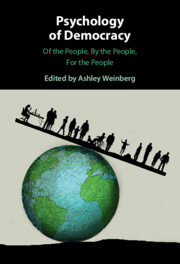Book contents
- Psychology of Democracy
- Psychology of Democracy
- Copyright page
- Contents
- Figures
- Tables
- Contributors
- Preface
- Acknowledgements
- Chapter 1 Psychology of Democracy
- Part I Of the People
- Part II By the People
- Part III For the People
- Chapter 14 Democracy as a Moral Challenge
- Chapter 15 ‘Can I Trust My Future?’
- Chapter 16 Religious Identity Politics and Genuine Support for Democracy
- Chapter 17 Psychology, Democracy and the Media
- Chapter 18 A Social Psychological Approach to Understanding China’s Democratisation
- Chapter 19 The Psychology of Radicalised Conceptions of Democracy
- Index
- References
Chapter 19 - The Psychology of Radicalised Conceptions of Democracy
Steps Too Far?
from Part III - For the People
Published online by Cambridge University Press: 24 February 2022
- Psychology of Democracy
- Psychology of Democracy
- Copyright page
- Contents
- Figures
- Tables
- Contributors
- Preface
- Acknowledgements
- Chapter 1 Psychology of Democracy
- Part I Of the People
- Part II By the People
- Part III For the People
- Chapter 14 Democracy as a Moral Challenge
- Chapter 15 ‘Can I Trust My Future?’
- Chapter 16 Religious Identity Politics and Genuine Support for Democracy
- Chapter 17 Psychology, Democracy and the Media
- Chapter 18 A Social Psychological Approach to Understanding China’s Democratisation
- Chapter 19 The Psychology of Radicalised Conceptions of Democracy
- Index
- References
Summary
In seeking overarching psychological explanations for barbarity and totalitarianism, there is a constant tug of reductionist logic that seeks to set aside the social, cultural and historical engines of radicalism and extremism and which leads to the inevitable conclusion that humans have an in-built and inevitable capacity to oppress and to destroy. However, in many respects, it can be argued that liberal democracies stand and fall on the underpinnings of the cliché that ‘one person’s terrorist is another person’s freedom fighter’. If only we understood our enemies better, and all that they have been through, then their world, and ours, would be a much better place. Meanwhile, a historical vista and understanding show that radicalised conceptions of democracy are a constant presence on both the far Left and Right of politics, often characterised by themes of coercive culture. This chapter will provide an analysis of the operation of such radicalised movements and will show how psychology has contributed to understanding them.
- Type
- Chapter
- Information
- Psychology of DemocracyOf the People, By the People, For the People, pp. 423 - 440Publisher: Cambridge University PressPrint publication year: 2022

